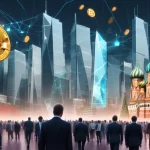Sberbank Launches Cocoa Index Token on Moscow Exchange: Russia’s DFA Market Expands

Russia’s Sberbank Launches Blockchain-powered Cocoa Index Token on Moscow Exchange
Sberbank, Russia’s premier financial institution, has launched the Cocoa Index Token on the Moscow Exchange, a digital financial asset (DFA) linked to the global price of cocoa. This move aims to open up the international agricultural market to Russian investors and provide a hedge against the weakening ruble.
- Sberbank introduces Cocoa Index Token on Moscow Exchange.
- Token linked to global cocoa prices, aimed at Russian investors.
- DFA market in Russia grows, but private blockchain networks limit access.
- Russia’s broader strategy involves DFAs to navigate sanctions.
- Ethical and geopolitical implications raised by this move.
The Cocoa Index Token is a DFA, a blockchain-based token representing a traditional asset, in this case, one kilogram of cocoa. It’s designed to give Russian investors a stake in the global cocoa market through a cash-settled futures contract, a contract that pays out in cash based on the price of cocoa. Alexander Zozulya, Director of Global Markets at Sberbank, enthusiastically states,
“We have developed a cocoa DFA that combines the traditional appeal of commodity markets and innovative technologies.”
This initiative reflects Sberbank’s drive to merge the old with the new, leveraging blockchain to enhance commodity trading.
While the DFA market in Russia has quadrupled in 2024, reaching a staggering value of 684 billion rubles ($8.3 billion), it’s crucial to understand that these assets are primarily traded on private blockchain networks. This exclusivity means that only companies and qualified investors can participate. The initial offering period for the Cocoa Index Token lasts up to four months, with the option for early redemption, adding a layer of flexibility for those looking to invest.
Russia’s financial landscape is rapidly evolving, with 98% of DFAs in the country being debt tokens, and a rising trend in hybrid and index instruments. Other banks, such as Alfa-Bank, are also venturing into this space, offering DFAs tied to gasoline and diesel fuel prices. This reflects a significant shift towards tokenized assets as a means of investment and risk management amidst global economic uncertainties and sanctions.
However, the introduction of the Cocoa Index Token isn’t without its complexities. Russia’s recent legislative changes allow for the use of DFAs to navigate around international sanctions, which raises ethical questions about the implications of such financial maneuvers. While this is a strategic move for Russia, it’s essential to consider the broader geopolitical impact. Anatoly Aksakov, the Committee Chair for Financial Markets, sees these changes as a way to bypass traditional banking systems and minimize external influence, highlighting the strategic use of DFAs in the face of international pressures.
The implementation of these new laws might face hurdles, particularly in onboarding foreign clients onto Russian DFA platforms. Despite these challenges, the potential for DFAs in international settlements is recognized. Russia’s involvement in the BRICS trade group and its efforts towards the BRICS Bridge platform, which could link central bank digital currency initiatives, suggest a broader strategy in the global financial landscape.
From a crypto enthusiast’s perspective, the use of private blockchains for DFAs might raise eyebrows. Bitcoin maximalists, for instance, might argue that this move lacks the decentralization and privacy ethos of public blockchains like Bitcoin. Yet, it’s undeniable that DFAs are pushing the boundaries of traditional finance through tokenization, even if on a private network. It’s a reminder that while Bitcoin leads the charge in decentralization, there’s room for various blockchain applications to coexist and innovate within their niches.
While the Cocoa Index Token is an exciting development, it’s vital to maintain a balanced view. The tokenization of commodities on private blockchains represents a significant step for Russia in its digital financial journey, but it’s a journey fraught with ethical and geopolitical challenges. As we move forward, it’s these very challenges that will shape the future of DFAs and their role in the global financial ecosystem.
Key Questions and Takeaways
What is the purpose of the Cocoa Index Token launched by Sberbank?
The Cocoa Index Token aims to provide Russian investors and companies with access to the international agricultural market and offer a hedge against the weakening ruble by being tied to the global price of cocoa.
How is the Cocoa Index Token structured?
The token is a digital financial asset (DFA) worth one kilogram of cocoa and is traded on the Moscow Exchange via a cash-settled futures contract.
Who can purchase the Cocoa Index Token?
Only companies and qualified investors are eligible to buy the Cocoa Index Token.
What is the current state of the DFA market in Russia?
The DFA market in Russia quadrupled in size in 2024, reaching a value of 684 billion rubles ($8.3 billion), with 98% of DFAs being debt tokens and emerging hybrid and index instruments.
How are DFAs regulated in Russia?
The Russian Central Bank is the sole regulator of the DFAs market, overseeing issuers and issuing operating permits.
What other types of DFAs are being offered by Russian banks?
Besides commodity-related DFAs like the Cocoa Index Token, Russian banks are also offering DFAs linked to gasoline and diesel fuel prices.
What are the ethical and geopolitical implications of Russia’s use of DFAs?
Russia’s use of DFAs to navigate around international sanctions raises ethical concerns and geopolitical tensions, as it represents a strategic move to counter global economic pressures.
How does the Cocoa Index Token fit into the broader global blockchain landscape?
While the Cocoa Index Token is a significant step for Russia, it highlights the broader trend of tokenizing traditional assets, which could reshape global finance but faces challenges due to its use of private blockchains and limited accessibility.



